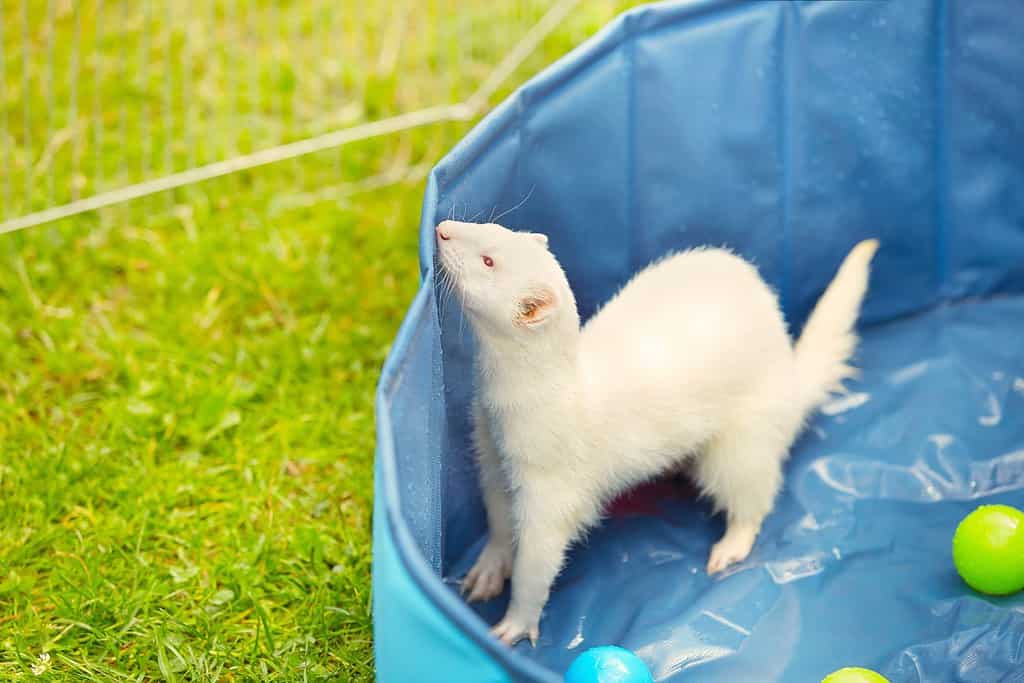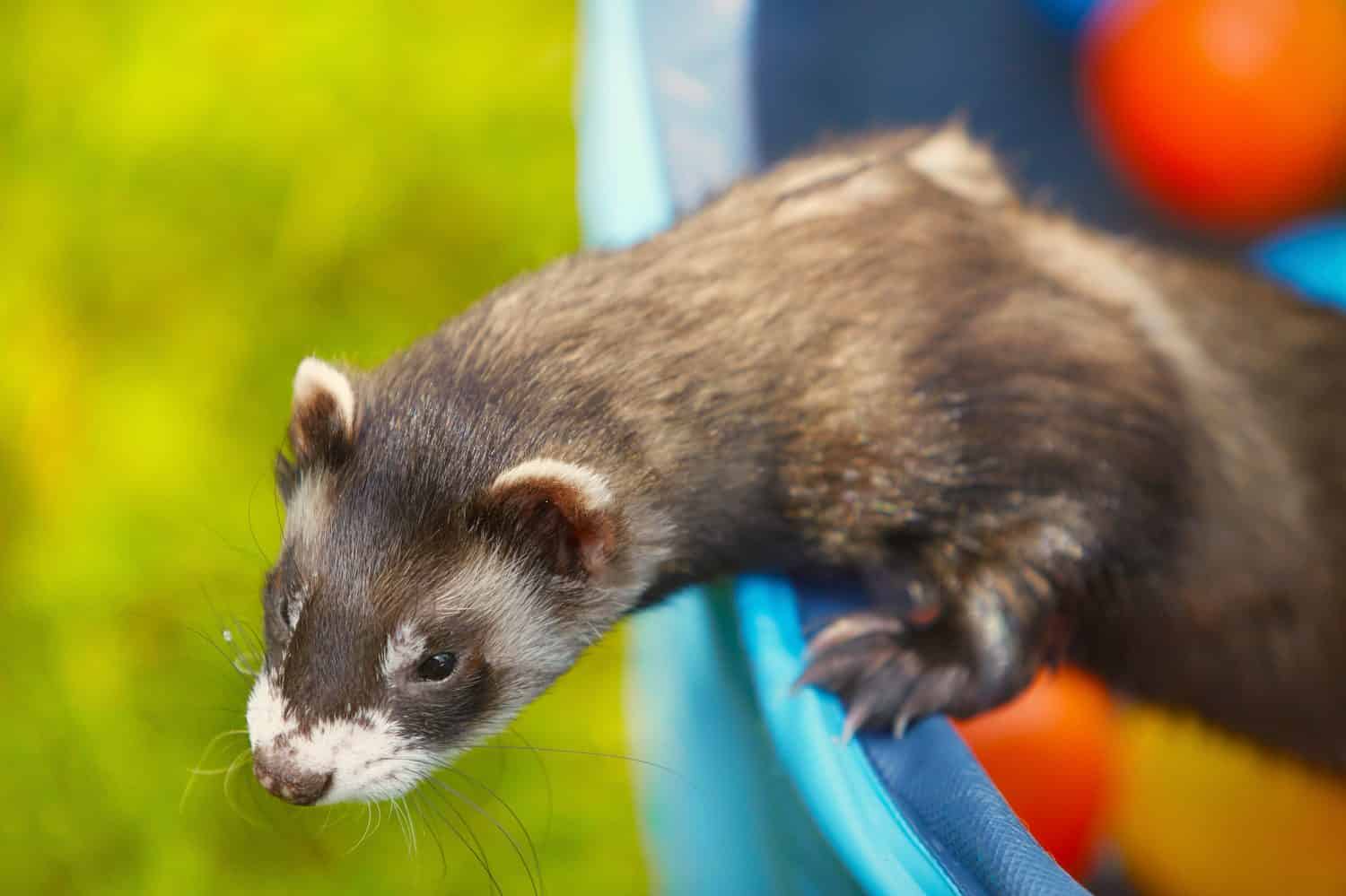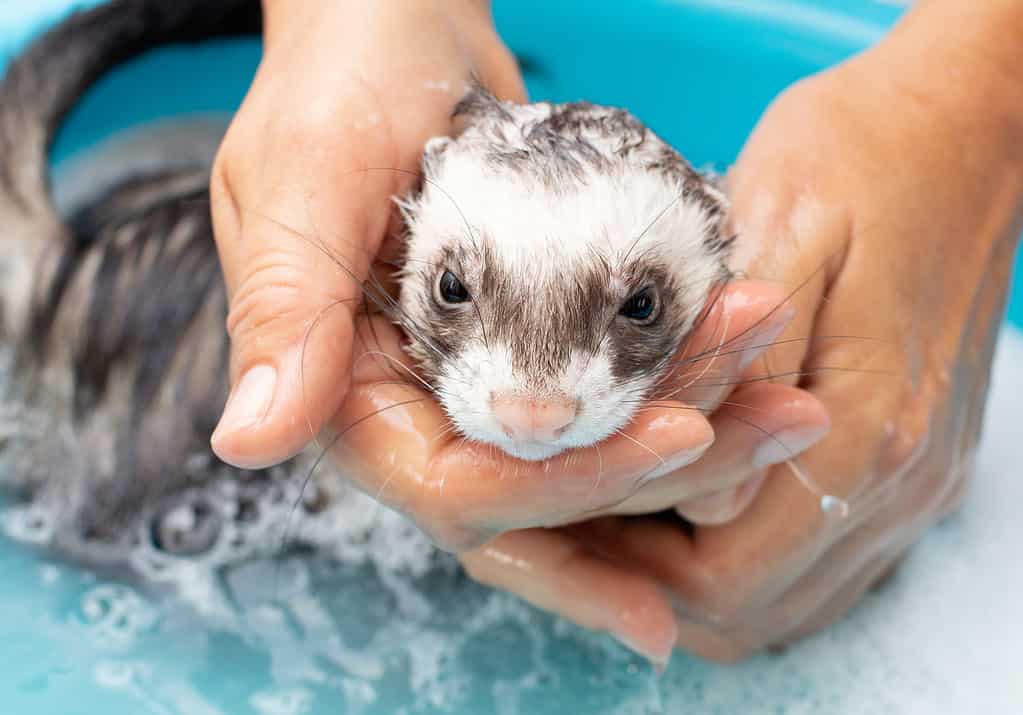Domestic ferrets are strong and agile swimmers just like their wild cousin, the European polecat. Many of these friendly and curious pets enjoy playing and splashing around in the water. Whether they’re chasing toys or wrestling with their friends, swimming can be an awesome exercise activity for pet ferrets. Although yours might love the water and prove quite good at swimming, several important precautions exist when allowing ferrets to swim.
#1 Ferrets Can Swim, but Start with Slow Introductions

Introduce your ferret to water slowly, and add toys to encourage them to play!
©Irina Vasilevskaia/iStock via Getty Images
Starting with just a small amount of water in a bowl or other small container is the best way to introduce your ferret to water and encourage them to swim. A huge bathtub filled with water may intimidate your ferret, which can lead them to refuse to get in and play. This is especially true if you place your ferret into deep water against their will. A traumatic experience like this might make them afraid of water for life.
Choose a small dish, such as a plastic tub used for leftovers. This way, your ferret can see through the object. You can even float treats on the water’s surface to encourage them to play. Once they become comfortable, you can increase the size of the water container.
Remember, your goal is to give your ferret a fun activity to enjoy! Eventually, you can add toys such as ping-pong balls that float easily on the water. Having your ferrets swim with friends may also encourage them to put aside their initial fear.
#2 Shallow Water

Always put your ferret in shallow water where they can touch all four feet to the ground with ease.
©Couperfield/Shutterstock.com
Sure, ferrets can swim and do it fairly well. However, until your ferret becomes absolutely confident with swimming, it’s best to only allow them into the water where all four feet easily touch the ground. Start out simple with a small amount of water in your bathtub or kiddie pool. As they build confidence, consider increasing the water level a bit, but always ensure they can stand up easily with their head above water.
#3 Easy Exit

Using a shallow pool or creating an easy exit is essential for ferrets to swim.
©Mocagrande/iStock via Getty Images
Ferrets may really love going for a swim, but providing them with an easy way to get out of the water is essential. This way, your ferret can choose how long they want to swim and play. Easy exists can include large rocks, a stepping stool, or a variety of other items that allow your ferret to get out of the water with very little effort. Creating an easy exit also helps to prevent our next precaution on the list.
#4 Ferrets Can Swim, but Watch Out for Exhaustion

Watch your ferret for any signs of exhaustion when they swim.
©Couperfield/Shutterstock.com
When ferrets swim, especially in deep water, they can quickly become exhausted. If they cannot stand up or otherwise keep their head above the water, they can easily drown. Make sure you have plenty of resting spots available and an easy exit for your ferret. This is especially true if your ferret has graduated to deeper water swimming.
#5 Get a Ferret Life Jacket

Try using a harness when you let your ferret swim.
©JLRphotography/Shutterstock.com
If your ferrets swim anywhere, consider getting a specially-made ferret life jacket. Similar to life jackets made for dogs, this safety device helps keep their head out of the water with very little effort. While it may be tempting to use a dog life jacket, it’s best to purchase one made specifically for ferrets. This is due to their significantly different body shape and weight. If your ferret refuses to wear a life jacket, consider a well-fitting harness or walking jacket instead.
#6 Use a Leash

Using a leash with your ferret’s life jacket or harness ensures you can draw them back to you if needed.
©Julie Gaia/Shutterstock.com
Along with a life jacket or harness, keeping a leash on your ferret while swimming anywhere outside your home is crucial to keeping them safe. If there’s an emergency, you have a quick way to get your ferret back into your arms! If swimming in the ocean, a strong tide or heavy waves could pull your ferret far from shore. Ferrets are strong swimmers, but fighting waves is not natural and can lead to drowning.
#7 Ferrets Can Swim, but Salt Water Can Be Dangerous

Ingesting too much salt water can poison your ferret.
©Robert Nieznanski/iStock via Getty Images
If you choose to let your ferrets swim in the ocean, be aware of the many dangers within. Obviously, think about potential predators, but also remember that ingesting too much salt water is a concern. Saltwater contains huge amounts of salt, which can lead to salt poisoning. This condition can lead to severe dehydration, vomiting, diarrhea, stomach ulcers, seizures, and even death.
#8 Fresh Water Can Be Dangerous, Too!

Rinse your ferret with clean water or give them a good bath after swimming to remove any potential chemicals and such from their coat.
©Irina Vasilevskaia/iStock via Getty Images
Perhaps the ocean is too scary a place to take your ferrets for a swim. However, fresh water isn’t without its own dangers. Many predators swim in the same lakes and rivers you may select. Be wary of what other animals exist in the area before allowing your ferret to swim.
Another group of problems with fresh water includes chemicals, bacteria, viruses, and parasites. If your ferrets swim in your pool at home, the chlorine/salt used to keep it clean could overwhelm their system. In wild waters, diseases and parasites could be ingested or otherwise take hold. It’s important to always rinse your ferret thoroughly with clean water after a swimming trip!
#9 Keep an Eye Out for Water Hazards

Water hazards, such as sharp rocks, could injure your ferret.
©Michel VIARD/iStock via Getty Images
Ferrets are small creatures, and despite their incredible swimming ability, objects hidden under the water’s surface could pose a threat to them. This includes sharp rocks, sticks, and litter that could injure your pet.
Also, note that items floating in or on the water may seem like toys or food to your ferret, which may cause them to accidentally ingest a foreign object. These objects could cause a blockage or otherwise damage internal organs.
#10 Hypothermia

Always get your ferret warm and dry after swimming.
©edierdel/Shutterstock.com
Swimming in cold water or not getting dry quickly can lead to hypothermia (low body temperature). Because ferrets are so small, they can lose body heat quickly in cold water or air during or after swimming. Be sure the water isn’t too cold and get them dried off fast after swimming.
The photo featured at the top of this post is © Achim Prill/iStock via Getty Images
Thank you for reading! Have some feedback for us? Contact the AZ Animals editorial team.






